A Diamond Jubilee

In 1947, a loaf of bread cost 13 cents, a gallon of gas cost 15 cents, and a new car could be purchased for $1,300. Jackie Robinson joined the Brooklyn Dodgers and “Miracle on 34th Street” debuted.
In October of that year, street railways, buses and rapid transit trains in Chicago began operating under a new, not-for-profit, publicly-owned governmental organization: the Chicago Transit Authority.
2022 marks the our 75th anniversary of operation, and we're celebrating this important milestone and our storied history this season.
Few other entities have played such an integral role in the everyday lives of Chicagoans, or have so influenced the growth and development of Chicago. CTA is woven firmly into the culture and life fabric of Chicago, touching communities across the entire city.
"For 75 years, Chicagoans have turned to the CTA to get them where they’ve needed to go," said CTA President Dorval R. Carter, Jr. "Our 75th anniversary gives us the chance to not only look back at our proud history, but also to look ahead to the improvements and investments we’re making to serve customers for another 75 years."
On this page...
A bit of early Chicago transit history...
Starting in the 1850s, a number of private companies built various elevated lines, street railways and bus lines that would service distinct parts of Chicago. They would expand and change the city, but would also overlap, duplicate each other and often compete for the same riders and, over their decades of existence would struggle to stay afloat.
To save these struggling systems and transit itself in Chicago, the State of Illinois in 1945 created the Chicago Transit Authority, which began operations on October 1, 1947 after acquiring the Chicago Rapid Transit Company and the Chicago Surface Lines, incorporating the Chicago Motor Coach Company a few years later and, with its lines, would form the foundation of the CTA you know today!
A brief, early history...
Numerous privately-owned companies built and operated elevated train, streetcar and bus lines throughout the region starting in the mid-19th Century, each innovating with new technologies to unserved areas in an ever-expanding city and each changing how people got around.
Over time, these systems, providing new and innovative services in their earliest days would also expand and overlap, often providing duplicative and inefficient service models unsustainably competed against each other.
Many of the earliest companies later merged and by the 1940s three primary companies remained for the city—the Chicago Rapid Transit Company (the 'L' system), the Chicago Surface Lines (who ran the city's streetcars and a number of bus lines), and the Chicago Motor Coach Company (with its own network of buses, including routes that continue today in the form of lakefront expresses and the 151 Sheridan).
Each then-for-profit entity was struggling to stay afloat, while being invaluable to the people of Chicago and its neighboring communities. Transit was something people agreed was worth saving, maintaining and making better.
A new era
In 1945, the Illinois state legislature created the Chicago Transit Authority with the passage of the Metropolitan Transit Act, which would consolidate the surface and rapid transit systems into a new, publicly-owned government agency.
CTA became an operating entity on October 1, 1947, acquiring and taking over the operations of the Chicago Rapid Transit Company and the Chicago Surface Lines: a new transit system was born. Immediately, work began toward modernizing these once-competing systems, remodeling them to remove inefficiencies and make them fully complementary.
Five years later, the Chicago Motor Coach Company had been acquired and CTA joined their services into the system, as well, completing the consolidation of transit in Chicago under the same, public-service-driven umbrella.
In these years since we first began operations under the CTA name, we've worked to grow and adapt to an ever-growing and ever-changing city, converting services to be more dynamic, accommodate new demand as the region grew outward, to simplify and speed up once massively complicated and slow systems and to continually renew and modernize historic infrastructure and fleets.
Today's CTA is the culmination of 75 years of work to improve and evolve a system that has its roots in the 1850s, has more miles of rapid transit railway than it's ever had, a fast, largely modern fleet and is the nation's second-most-heavily-used transit system, today.
CTA timeline
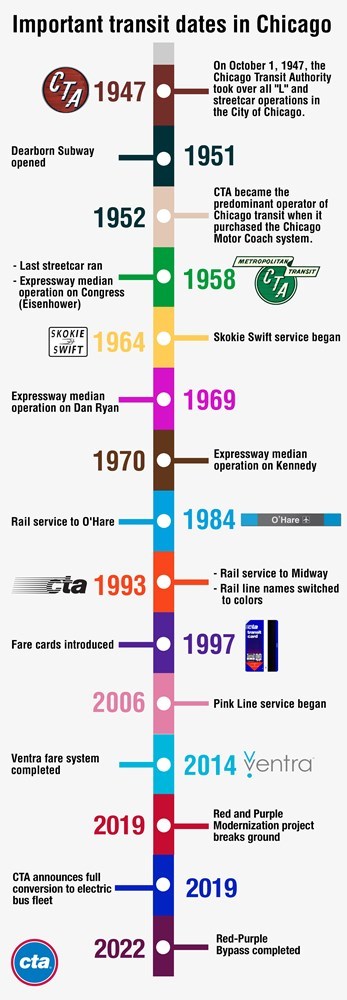
75th Anniversary events
On Saturday, October 1, 2022 we will celebrate 75 years of service—a diamond jubilee!
To honor our history and, most importantly, to say "thank you" to all of you who we serve, we'll be bringing out our Heritage Fleet buses and trains for you to ride and enjoy.
We'll also have some commemorative giveaways, including some limited-edition posters and tickets to board some of the first historic train trips around the Loop.
Meet us at Daley Plaza
Starting at 9:30am on the big day, we'll have a table set up at Daley Plaza (where the iconic Picasso sits, downtown) where we'll be providing information about available trips, giving away limited-edition posters to commemorate this special event and issuing tickets to board the first train trips on our older historic trains (see below) running around the Loop 'L'.
Take the 'L' to Washington on the Blue Line, Lake (accessible) on the Red Line or Clark/Lake (accessible) on the Blue Brown, Orange, Pink and Green Lines to reach Daley Plaza. (Get directions with Google Maps)
Ride historic trains
We plan to have all three of our operable historic trains running around the Loop 'L' from 10am-2pm, including a two-car train of 4000-series railcars (two from 1923), a two-car train of 6000-series railcars (two from 1959) and a four-car train of 2400-series railcars (from the late 1970s).
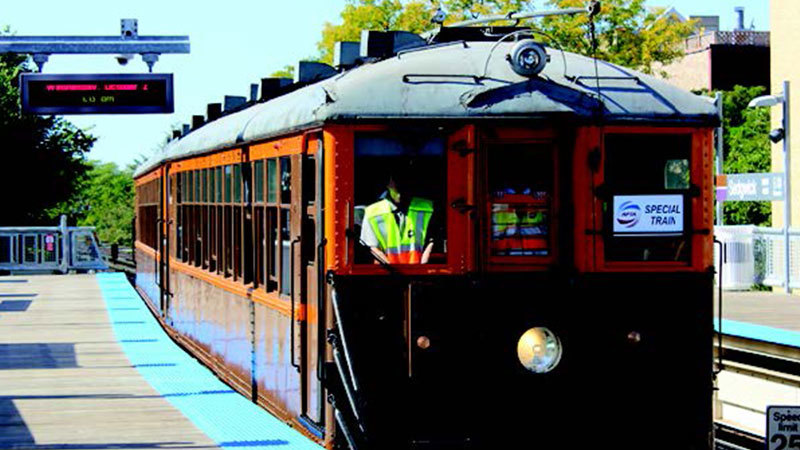
4000-series railcars (delivered 1923)
Board at Clark/Lake on the Orange/Pink lines platform. (Regular fare required to enter 'L' system).
Train will run continuously, boarding from about 10:00am-2:00pm, around the Inner Loop track.
The first three trips (about 10:00am-10:45am) will require special tickets to board to help ensure everyone's comfort—visit our volunteers in Daley Plaza for tickets.
After 10:45am and the first three ticketed trips have ended, the cars will make additional, limited stops around the Loop, boarding on the Orange/Pink lines side at Clark/Lake, Washington/Wabash, HW Library and Quincy.
 Learn more about these railcars
Learn more about these railcars

6000-series railcars (delivered 1959)
Board at Clark/Lake on the Orange/Pink lines platform. (Regular fare required to enter 'L' system).
Train will run continuously, boarding from about 10:00am-2:00pm, around the Inner Loop track.
The first three trips (about 10:00am-10:45am) will require special tickets to board to help ensure everyone's comfort—visit our volunteers in Daley Plaza for tickets.
After 10:45am and the first three ticketed trips have ended, the cars will make additional, limited stops around the Loop, boarding on the Orange/Pink lines side at Clark/Lake, Washington/Wabash, HW Library and Quincy.
 Learn more about these railcars
Learn more about these railcars
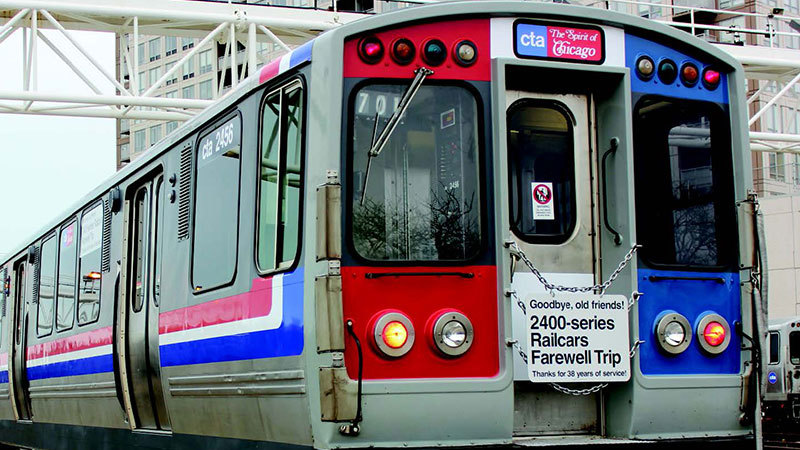
2400-series railcars (delivered 1976-1978)
Board at Clark/Lake on the Brown Line platform side (or at additional limited, stops to be made by this train, including Washington/Wabash, HW Library and Quincy, also on the Brown Line side). (Regular fare required to enter 'L' system).
Train will run continuously, boarding from about 10:00am-2:00pm, around the Outer Loop track.
 Learn more about these railcars
Learn more about these railcars
Ride historic buses

Flxible 8499 (unique, experimental bus delivered in 1960)
Board at Washington/Clark-Dearborn Loop Link station across from Daley Plaza.
Bus will operate about every 15 minutes in a loop around downtown from approximately 10am-2pm; no fare required.
 Learn more about this bus
Learn more about this bus
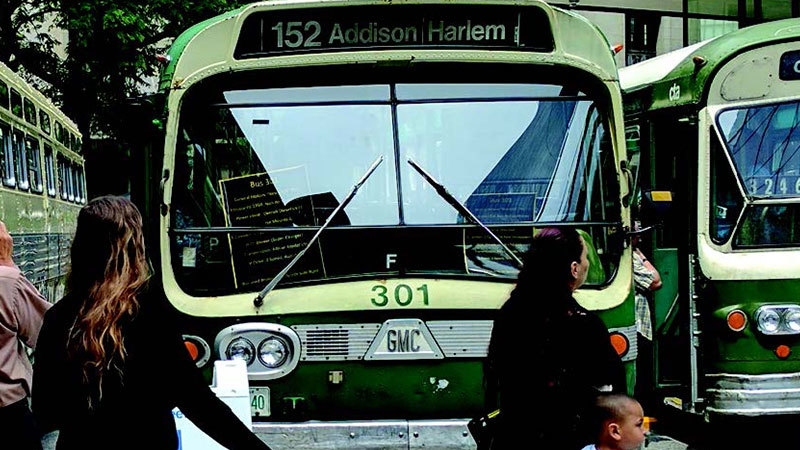
GMC 301 (delivered in 1962)
Board at Washington/Clark-Dearborn Loop Link station across from Daley Plaza.
Bus will operate about every 15 minutes in a loop around downtown from approximately 10am-2pm; no fare required.
 Learn more about this bus
Learn more about this bus
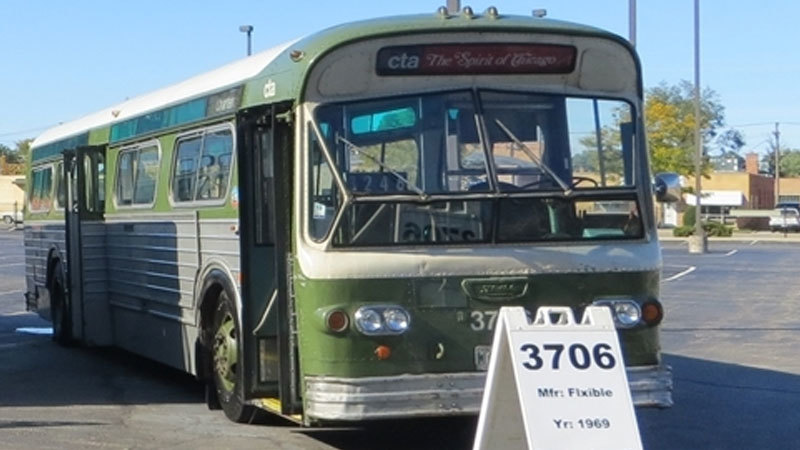
Flxible 3706 (delivered in 1969)
Visit bus, on display for photos and touring, parked on Daley Plaza.
 Learn more about this bus
Learn more about this bus
. . . times subject to change